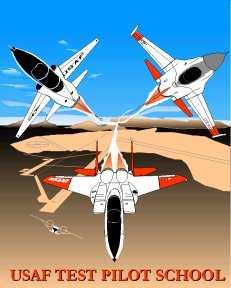 The increasing push for a
military space force has led Department of Defense officials to
expand the Air Force envelope to include space education, with an
emphasis on military applications.
The increasing push for a
military space force has led Department of Defense officials to
expand the Air Force envelope to include space education, with an
emphasis on military applications.
The U.S. Air Force Test Pilot School has followed suit,
answering DOD’s call by creating the first Aerospace Vehicle
Test Course. The four-week course for qualified engineers includes
approximately 80 hours of academics, supplemented with projects,
simulations, field trips and flying, said Maj. Russ Adelgren, the
course director.
It covers a wide spectrum of aerospace disciplines, from the
history of aerospace planes to the launch and return of the space
shuttle. "We currently have two hours of spacecraft re-entry and
one hour on thermal-protection systems," Adelgren said, "but due to
the recent space shuttle disaster, we added another hour to discuss
lessons learned from Columbia's destruction. We are always trying
to keep the course as updated as possible."
The course also offers students the unique opportunity to
actually apply everything they learn, Adelgren said. "The students
receive a T-38 (Talon) and an F-16 (Fighting Falcon) ride, two
glider rides and a 'vomit comet' ride (in NASA’s zero-gravity
trainer)," Adelgren said.
The course includes field trips to the rocket labs and the
rocket-launch vehicle operations and test complex at Edwards, the
Vandenberg Spaceport at Vandenberg Air Force Base, Calif., and the
Johnson Space Center in Houston, Texas.
The Micro Satellite Launch Vehicle program was a new block of
instruction added. It gives the students a chance to fly an F-15
Eagle simulator, conduct a simulated launch profile and man the
NASA-Dryden control room, Adelgren said.
"With this addition to the curriculum, the students were able to
practice proper test discipline, while executing a test mission on
a real-world project,” he said.

"My fellow classmates and I were given a once-in-a-lifetime
opportunity, a chance for young engineers to develop into future
space flight testers," said Jason Torres, an engineer from the
412th Test Wing here. "This course used both academics and
applications to illustrate flight test versus atmospheric flight
test. Nowhere else can one receive a year's worth of hands-on
aerospace education in the span of one month."
The training was invaluable, according to 1st Lt. Damen Provost,
an engineer with Air Force Space Command’s Space and Missile
Center Detachment 12 at Kirtland AFB, N.M.
"The students represented a wide variety of Air Force
specialties, bringing knowledge from the course back to their
respective units,” he said. Although the fundamental
philosophy of testing is the same for aircraft or spacecraft, it is
invaluable to have aerospace-vehicle experts teach this course,
Adelgren said. Therefore, not all instructors are members of the
school staff, but they come from around the country to lend their
aerospace expertise to the course, he said. Currently, there are
about 25 teachers involved in the program, which holds courses
about once every 18 months.

All students must have a bachelor’s or master’s
degree in aeronautical, aerospace or astronautical engineering, or
have a strong background in one of these fields. Students must also
be medically qualified to fly and pass a Class-III physical.
"If you are lucky enough to attend this course, you can say that
you were in the right place at the right time," said Johnny
Armstrong, the chief engineer and course instructor at the access
to space office. "You will be a part of the exciting future of the
space program, learning how to test hypersonic vehicles in support
of the Air Force mission." [ANN Thanks Capt. Catie Hague, Air Force
Flight Test Center Public Affairs]
 ANN's Daily Aero-Term (05.16.24): Instrument Runway
ANN's Daily Aero-Term (05.16.24): Instrument Runway ANN's Daily Aero-Linx (05.16.24)
ANN's Daily Aero-Linx (05.16.24) Airborne 05.15.24: Ghost Sq MidAir, B-2 Junked, Dream Chaser Readies
Airborne 05.15.24: Ghost Sq MidAir, B-2 Junked, Dream Chaser Readies Airborne 05.10.24: Icon Auction, Drunk MedEvac Pilot, Bell ALFA
Airborne 05.10.24: Icon Auction, Drunk MedEvac Pilot, Bell ALFA Airborne Affordable Flyers 05.16.24: PRA Runway, Wag-Aero Sold, Young Eagles
Airborne Affordable Flyers 05.16.24: PRA Runway, Wag-Aero Sold, Young Eagles





